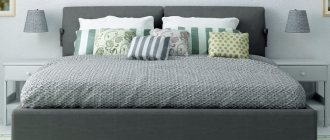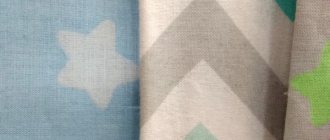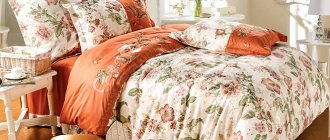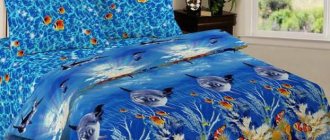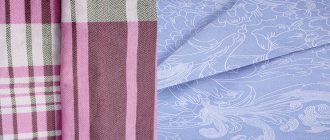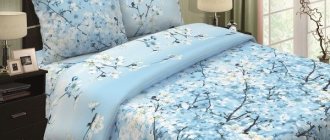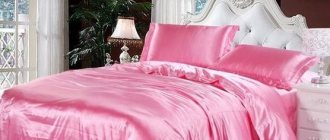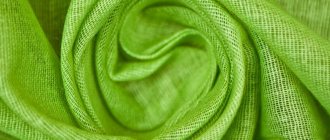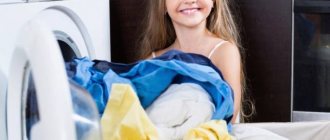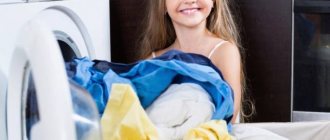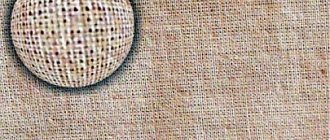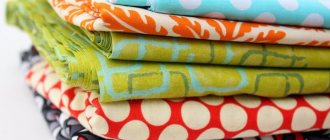Percale is a surprisingly durable fabric. At one time, it was used to make skins for the first aircraft, sails and parachutes, and now products made from it are classified as “premium”.
Initially, this fabric was a 100% cotton fabric made from long-pile threads. Later, silk, polyester and polyester were added to weaving.
The density of modern percale is 100-160 threads per 1 square centimeter .
Sometimes the main material is not cotton, but linen. Variability does not affect the quality in any way. It will not be possible to distinguish one type from another either visually or by touch.
Both are created exclusively from untwisted threads of the same length, hence their smoothness and resistance to wear.
The villi are connected to each other using a special solution. It doesn't wash out. The fabric made from it does not delaminate after washing, but becomes softer. Not afraid of high temperatures.
History of fabric
The specific technology of percale weaving was first mastered in medieval India. Mass production of the material began at the end of the 17th century in French industrial manufactories. The fabric then had a technical purpose: additionally processed with oil or organic resin, it was used for the production of ship sails. At the dawn of aviation, the material impregnated with varnish began to be used to create parachutes and cover aircraft bodies. In the 70s of the 20th century, light camping tents were made from percale.
Photo source: Depositphotos.com
The introduction of thin threads into production brought the fabric into the sphere of household use: soft and durable percale home textiles quickly gained popularity.
How to spot a fake
Due to the great interest shown in percale fabric, it began to be counterfeited very often. To protect yourself from counterfeiting, you should purchase material only at large points of sale, having first examined the surface of the fabric and the label indicating its composition. You should not look for a cheaper product, since this type of material is considered expensive and savings can be achieved by replacing components.
When purchasing, be sure to ask for quality certificates that natural fabrics must have. If the packaging is tight, ask to unwrap it and take a closer look at the purchased product. Natural fabric is made from untwisted threads and has no gaps due to its high density.
Application
- The main area of application of percale is sewing luxury bedding sets. First-class percale linen ensures a comfortable, healthy sleep.
- Percale home textiles give comfort: bedspreads, tablecloths, decorative napkins.
- The material is used to sew pillow covers, mattress covers, and the top layer of blankets.
- Thin fabric is suitable for sewing wardrobe items: women's blouses, dresses, men's shirts.
- Technical percale is used in industry for sewing parachutes and awnings.
Photo of percale
Photo No. 1 Percale fabric (snow-white bedding)
Photo No. 2 Percale fabric (close-up)
Photo No. 3 Percale fabric (close-up)
Photo No. 4 Percale fabric (peach cut)
Photo No. 5 Percale fabric (with ornaments)
Photo No. 6 Percale fabric (with embroidery)
Photo No. 7 Percale fabric (for couples)
We strongly advise you to familiarize yourself with sets made from other materials before purchasing percale bed linen. In this case, there is something to overpay for, reviews testify to this, but the purchase of goods made from percale can greatly affect your wallet.
Description of the fabric: composition, properties, characteristics
Classic percale is a material made from long-staple combed cotton. The fabric is smooth, soft and delicate to the touch, surprisingly pleasant to the body. It retains heat, allows air to pass through, allowing the body to breathe, absorbs moisture, and does not accumulate static electricity.
The threads of the fabric fit tightly to each other, the percale does not show through. The linear density of the fabric ranges from 90 to 160 threads per 1 cm². Surface density is 72-150 g/m2 depending on the type of material.
Production Features
Percale is made from long-fiber raw materials. Cotton or linen is combed out and thin, smooth threads are pulled out. They are not twisted in the usual way. The fabric is woven in a cross-shaped plain weave.
Instead of twisting, another procedure is used: treatment with an adhesive composition - sizing. Its main components:
- Potato starch.
- Animal fat. litcerin.
- Glycerol.
Sometimes other ingredients are added. Each thread is impregnated with this composition. The result is a fabric that is strong, yet soft and lightweight. Prevents yarn breakage and lint from appearing. Sizing is somewhat reminiscent of starching. But unlike a similar procedure, the sizing is not washed out of the fabric during use. The composition simply softens with each subsequent wash.
At the beginning of the twentieth century, the adhesive composition resembled liquid rubber, and its use gave the exact opposite result. The treatment resulted in the production of rubberized fabric with a specific odor. Contact with the body caused unpleasant sensations. Percale did not absorb sweat and did not allow air to pass through. Therefore, it began to be widely used in the aviation and marine industries - to create airplanes, parachutes, and sails. Thanks to innovative technologies, today customers have the opportunity to choose a gentle material that does not irritate the skin.
Types of fabric
Fabric is classified by composition:
- cotton percale;
- percale with added flax;
- material with polyester additives;
- percale with added silk.
Depending on the purpose, the material is divided into:
- household - intended for home use;
- technical - has a special purpose, used in industry.
What are they sewing?
On the Internet, one of the most popular questions on forums for seamstresses is the question: what is sewn from percale? Depending on the composition, different types of fabric are used to sew all kinds of products in different fields.
| Household | Technical |
| bedding sets | parachutes |
| covers for mattresses and duvets | shopping awnings |
| pillowcases | sails for yachts |
| curtains | tents and sleeping bags |
| tablecloths | flags for ships |
| men's and women's clothing: shirts, dresses, blouses, skirts | protective capes |
The material showed itself especially well in models of complex cut with additional finishing.
In addition, percale material often serves as a base for embroidery.
Percale, which is used for technical purposes, is additionally rubberized and then covered with a layer of aluminum. In this case, even in extreme situations, the fabric can withstand significant loads. At the same time, the material is often treated with special chemical mixtures that protect it from the absorption of excess moisture and rotting processes, and also prevent fire.
Advantages and disadvantages
Percale has a myriad of advantages, among which it is worth noting:
- strength;
- softness;
- long service life: sets of linen can be used for up to 10-15 years;
- wear resistance: the fabric does not deform, does not fade in the sun, does not fade, and is not subject to pilling;
- pleasant tactile sensations and aesthetic appearance;
- saturation, color fastness;
- hygiene, comfort in use: the material is characterized by hygroscopicity, heat-saving properties, and breathability;
- impermeability: does not allow down and feathers to escape, maintains the integrity of the stuffing.
The disadvantages of the fabric include:
- shrinkage is possible within 3%;
- The components of the dressing can cause allergic reactions on sensitive skin.
Virtues of royal matter
The positive properties of the fabric arise from its quality characteristics. The advantages of percale include:
- Comfort. The bedding filler is securely hidden inside, and the smooth, velvety texture allows you to relax and have a good rest.
- External aesthetics. This bed looks very beautiful: snow-white pillowcases or multi-colored sheets can be complemented with decor. The color is clear, the drawings are clear and bright. The tight fit of the threads ensures uniformity.
- Inert to sunlight. Percale is not afraid of ultraviolet radiation. Products made from it do not fade, thanks to the coating with sizing.
- Resistance to deformation. Does not lose shape even after repeated washings, slight shrinkage is possible - up to 2% over the entire period of use.
- Ease. Despite its density, matter has little weight. She is practically weightless. Doesn't take up much space when stored in a closet or chest of drawers.
- Easy to care for. The material is easy to wash, dirt is quickly removed from the surface. At the same time, he is not afraid of high temperatures.
- No processing difficulties. The fabric is easy to cut, does not slip, and the cuts do not unravel or fall off.
- Antistatic. The production features made the linen not subject to electrification. Percale does not require any special treatment.
- Durability. With proper care, percale products will last 10 years or more. They can withstand up to 1000 washing cycles.
These positive aspects have led to the fact that the material is called royal and is used in the production of elite sets.
Percale and its analogues
The percale material is similar in composition and consumer properties to poplin, satin and calico.
- Percale linen is a leader among its peers in terms of wear resistance and strength.
- Compared to satin, percale is harder, less smooth, and does not shine at all. Satin wins in visual appeal, but percale is more breathable, shape- and color-resistant, and wicks away moisture better.
- Compared to poplin, percale is denser and rougher to the touch. A clear advantage of percale is its low wrinkleability, while poplin requires ironing after each wash. In other characteristics, the fabrics are as similar as possible.
- Compared to coarse, rough-feeling calico, percale is famous for its smoothness, delicacy and softness, and has less weight and greater density. In other properties, high-quality calico is quite comparable to percale and successfully competes with it.
Percale, calico, poplin, satin: learning the differences between cotton fabrics
Very often there is a situation when a buyer, entering a store, is surprised by the large variation in the cost of goods and is sincerely surprised: “But, why?”
This also applies to cotton (and not only) fabrics, as well as products made from them. With great pleasure I will tell you why.
To begin with, I will touch on the very basics, without going into global details.
Cotton fiber production
The first thing that affects the cost of future fabric is the quality and grade of the cotton box itself, from which cotton fiber is subsequently spun. Before you start working with the material, it is checked for quality, the length and thickness of the fibers, and the type of cotton are determined. All this is done in order to determine how to most rationally use raw materials and conduct the technological process. After evaluation and inspection, the spinning material is sent for processing. To ensure a certain stable quality of yarn, raw materials from different batches are mixed.
Impurities
In addition to cotton, the fiber may contain impurities that are added to the composition for various purposes, be it strength or elasticity. Nylon, spandex and other synthetic fibers are added. Their content in fabrics is minimal and is allowed by GOST, since in many cases fabrics only benefit from this. But this makes them cheaper.
Cotton spinning
Our natural fabrics, which have a huge number of names, are made from finished - processed and bleached fibers. When you wander between samples, without going into details about spinning techniques, it is very difficult to distinguish - why does calico cost so much, and some poplin is already more expensive? And satin is so expensive!
These fabrics differ in their weaving. Here are their main varieties.
Plain weaving
The simplest weave in which the warp and weft threads alternate. This weaving gives the fabric strength. With increased density, the stiffness of the fabric increases. The fabric is the same on both sides. However, even with the same weave, the fabrics feel different to the touch.
Assortment of fabrics
Cotton: calico, chintz, cambric, calico, flannel, voile, poplin, taffeta, marshmallow. Linen: trim, canvas, linen. Silk: various crepes (crepe de chine, crepe chiffon, crepe georgette, crepe marroquin) Woolen: cloth, some suit and dress fabrics. Others: homespun fabric.
Twill weave
Forms a characteristic scar running diagonally across the fabric - from bottom to top and from left to right. The angle of inclination depends on the thickness of the thread, the density of the warp and weft.
Assortment of fabrics: twill, semi-silk lining fabrics, semi-woolen fabrics on a cotton base. The main twill weave is used to produce semi-silk fabrics with a silk warp and a cotton weft; the weft twill weave is used to produce semi-woolen fabrics with a cotton warp and a wool weft.
Satin or satin weave
Forms a scar diagonally from right to left. The threads are very thin (only high-quality 100% cotton is used, most often Egyptian long-staple cotton). The weaving is very tight.
Range of fabrics:
Cotton: satin, eraser. Linen: kolomenok (satin weave). Silk: satin, crepe-satin, lining fabrics, liberty. Woolen: some drapes, beaver, flannel on a cotton basis. Others: corset fabrics.
Perhaps these are the main criteria for the quality of the canvas. Additionally, I would like to go into some types of fabrics that I actively use in my works.
Poplin
Fabric in the production of which the plain weave method is used. The peculiarity of this fabric is that small scars can be seen on its surface. They arise due to the fact that threads of different thicknesses are used. A thinner thread is chosen for the warp, and the thicker one is used for the weft. This method of weaving fabric was first developed in France in the Middle Ages. More precisely, this happened in the town of Avignon. Thanks to the above-mentioned features of poplin, it is quite pleasant and soft to the touch. In terms of density and strength, poplin is comparable to the fabric that is used for sewing workwear. The peculiarity of poplin is that it looks great in almost any color. If we talk about the production of poplin today, it can be noted that it can be bleached, variegated, printed or plain-dyed. Most often you can find poplin bed linen on sale. This bed linen is distinguished by the fact that it is not only durable, retains its shape and color well, but also has a pleasant soft surface of the fabric. Moreover, since bed linen is most often made from cotton fabrics, poplin is distinguished by the fact that it retains heat well, perfectly absorbs moisture and allows the body to breathe. All this is necessary to create a feeling of coziness and comfort. You can also see on sale night pajamas, men's shirts, women's dresses and many other products intended for everyday wear made from this fabric.
Photo: white and with a floral print - poplin. Light brown - percale. Dark brown - calico.
Calico
Composition: 100% cotton. On the Russian market they are presented mainly in widths of 150 cm and 220 cm. According to Russian state standards, calico is 100% cotton. “Calico” is the most famous, traditional fabric, fairly densely woven (made of thick threads) and without much shine. There are several varieties of it with a density from 50 to 130 threads/cm2: “universal”, “crepe”, “ranfors”, “luxury”, etc. The higher the density (and the thinner the thread), the higher the quality of the fabric. Bedding sets made from calico are very practical and quite cheap. However, if you compare it, for example, with satin, the thickening of the threads and the usual cross weaving are clearly visible in the structure of the material itself. Yes, calico is certainly cheaper than satin or silk, but it is quite high-quality bed linen for those who, by and large, are not so interested in the elegance and softness of the fabric. ATTENTION! According to the “guest standards”, or rather the specifications of China, Turkey, Pakistan, and so on, up to 15% of polyester thread is allowed. The fabric consequently becomes cheaper due to the price difference between cotton and polyester.
Satin
Satin (French satin, from Arabic zaytuni, from Zaytun - the ancient Arabic name of the Chinese harbor of Quanzhou, from where this fabric was exported) is a fabric of satin weave of cotton fiber threads. It has a smooth, silky front surface, on which weft threads predominate; quite dense and shiny; It is produced mainly plain-dyed, printed and bleached. Used for making dresses, men's shirts, and so on. Due to its qualities, satin is widely used for making bed linen. Satin is made from double-woven twisted cotton thread. It has long been noted that the more the thread is twisted, the brighter the shine. This is how gloss appeared - satin, reminiscent of silk. Satin linen is durable and can withstand a large number of washes - 300-400, and only after quite a long time does the material begin to fade a little. It is cheaper than silk, but more expensive than other cotton fabrics. It is used to make underwear of various designs for everyday use. Satin bedding is best suited for daily use, without losing its impeccable appearance and strength even after repeated washing.
Photo: black - satin. Gray - percale.
Percale
In Europe, percale was created in the 18th century specifically for the bedrooms of French royalty and is well known as luxury bed linen. Since then, this fabric has been a symbol of refined taste and true beauty. The secret of percale lies solely in the natural properties of the long-staple Egyptian cotton from which it is made. The fabric is extremely dense and extremely durable, while at the same time being soft and smooth to the touch. Percale is a thin, high-density cotton fabric with a plain weave. Long-fiber varieties of cotton are used in production, which ensures high consumer properties of the material. Percale is a very silky, soft fabric, reminiscent of cambric in appearance. Percale has a long service life and washes well.
As a conclusion
I will be glad if this article is useful to someone. Personally, the first time I went to a fabric store, I was very confused by the difference in cost between materials. Perhaps, at first glance, I could only distinguish fleece, because I had dealt with it before. I didn’t see the difference between calico and poplin, between percale and satin.
Having understood some of the subtleties (of which there are probably many more), I see:
Calico is quite loose, rough and the threads have a difference in thickness. It feels good when cutting the material.
It behaves poorly under the needle of the machine; it requires some skill so as not to pull the entire fabric together with the thread that landed directly on the needle. I have not yet dealt with higher quality calico. But, in combination with denser fabrics like poplin and percale, it looks great. That fine line where a slight difference in texture gives a product its charm.
Poplin and percale are quite similar. Even when working with them, I probably only see the difference on the inside and feel it tactilely a little. Percale has a reverse side, while poplin is identical on both sides. Percale is smoother and denser. Having already cut out the parts, it’s scary to sew the percale on the wrong side, which is slightly different, but will be noticeable in the finished product. At least in color intensity and shine.
They behave well under the sewing machine needle. The threads do not pull the entire fabric together once they hit it. And after, the canvas successfully takes on its original appearance.
satin for the first time when I couldn’t find the desired black color among other fabrics. It is shiny and slightly slippery to the touch. Its price is justified, since it has a particularly amazing tactile sensation, looks expensive and solid. I am already set on purchasing jacquard satin (this is a method of producing fabric in which a pattern, similar to patterns on frozen glass, is created by changing the height of individual loops. There is no embossing or dyeing, only weaving, so this type of fabric can be considered the most natural and environmentally friendly. After washing, the jacquard forms a barely noticeable pile, which is very pleasant to the body).
But, like any other fabric, it has its drawbacks.
For all its strength and durability, it wrinkles a lot. I'm very glad that this is not a problem for the pillows, as the fabric on them is always slightly taut and does not wrinkle. But, newly purchased fabric must first be ironed before cutting.
The second problem is its statics. If you have fur-covered friends in your home, the pillow will collect it on itself. The fabrics listed above do not magnetize it that much. Therefore, if you liked working with satin so much, match it to the color of your cat or dog.
That's probably all. See you again!
Care instructions
Percale is an easy-care fabric, but to maintain its attractiveness and unique properties it requires care and compliance with the manufacturer's recommendations.
General rules:
- The first wash is done in water at 30-45 degrees to maintain brightness and color saturation.
- For subsequent washes, temperatures up to 80 degrees are permissible. Linen should not be pre-soaked or boiled.
- Machine washable with spin speed up to 800 rpm. White linen is washed separately from colored linen. It is recommended to turn items inside out before washing.
- Do not use chlorine bleach; mild detergents are recommended. To soften hard water you need a conditioner.
- Dry percale products naturally, by hanging them and spreading them well on ropes or a special dryer.
- The optimal iron temperature for ironing is no higher than 150 degrees.
Varieties
Percale material is divided into two categories: household and technical. Household used for sewing mattress covers, bed linens, clothing items, and bed linen. Technical, mainly with the addition of synthetics, is used for the manufacture of awnings, parachutes, tourist tents and other products that require special strength and stability of use. Household percale is divided into bleached, plain-dyed and printed. Separate categories are jacquard and embroidered.
There is differentiation in composition. Information about it is in the table:
| Main component | Added fibers | Beneficial features |
| Cotton threads | Flax fibers | Hypoallergenic, pleasant to the body |
| Cotton threads | viscose | Density, light gloss, durability |
| Cotton threads | Polymer threads | Strength, density, softness |
Percale bed linen can have various beneficial properties, which are determined by the amount and type of additives. On natural fabric you can find a label that says 100% cotton or percale cotton. Otherwise, the percentage of cotton fibers, as well as additives made by the manufacturer, is written.
Author:
Anastasia Kukushkina
I hope you enjoy the article I have prepared for you! If you find errors in it, write to me about it! I will answer any questions you have, ask them!
